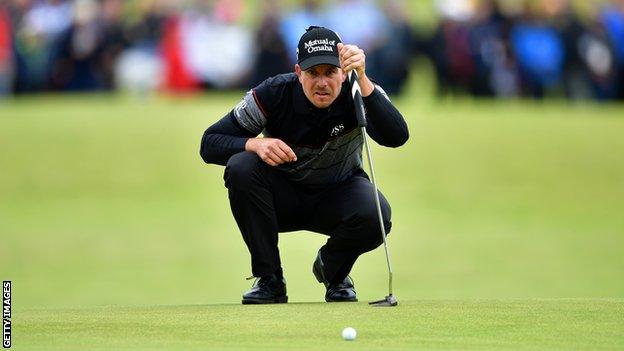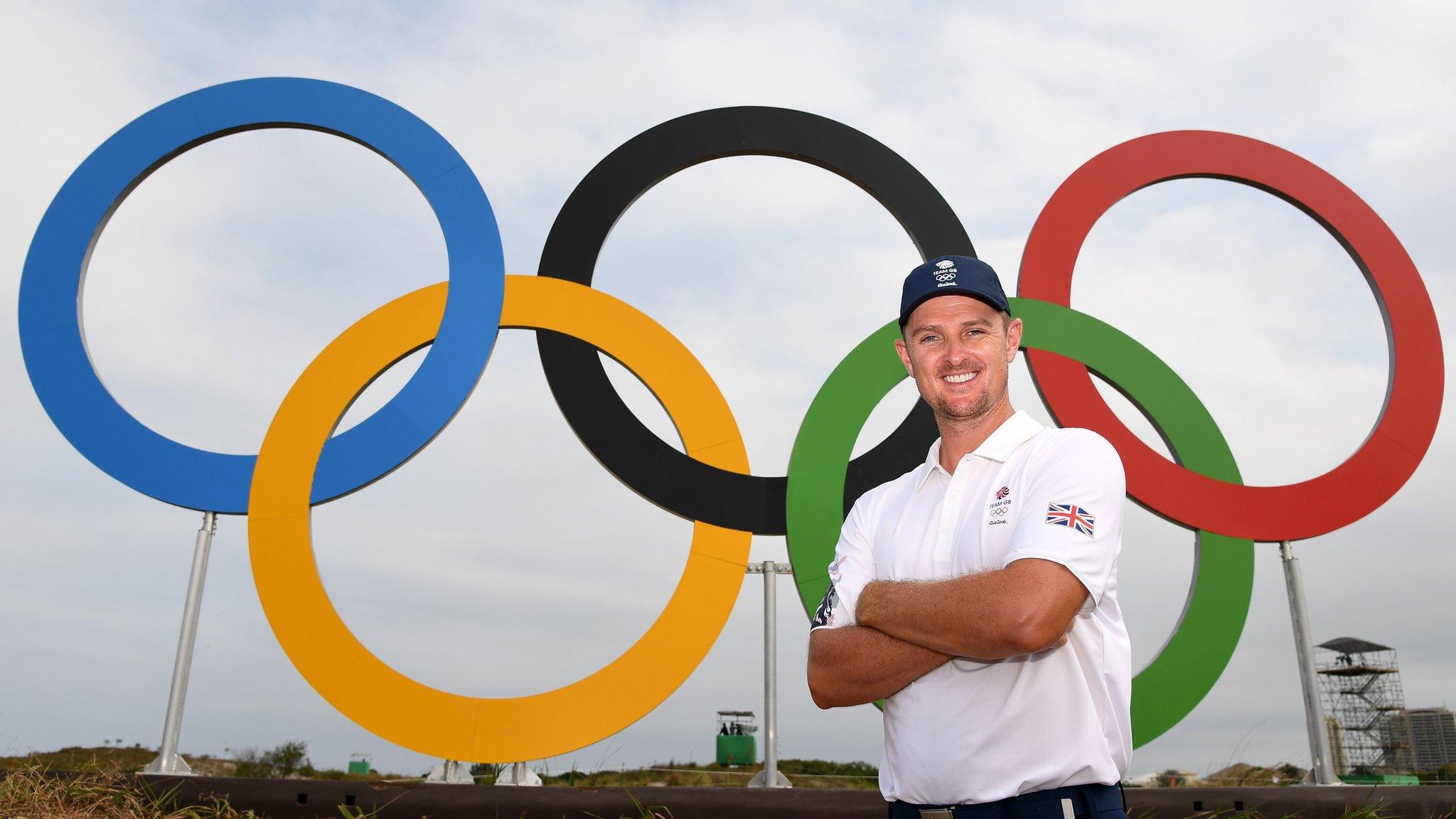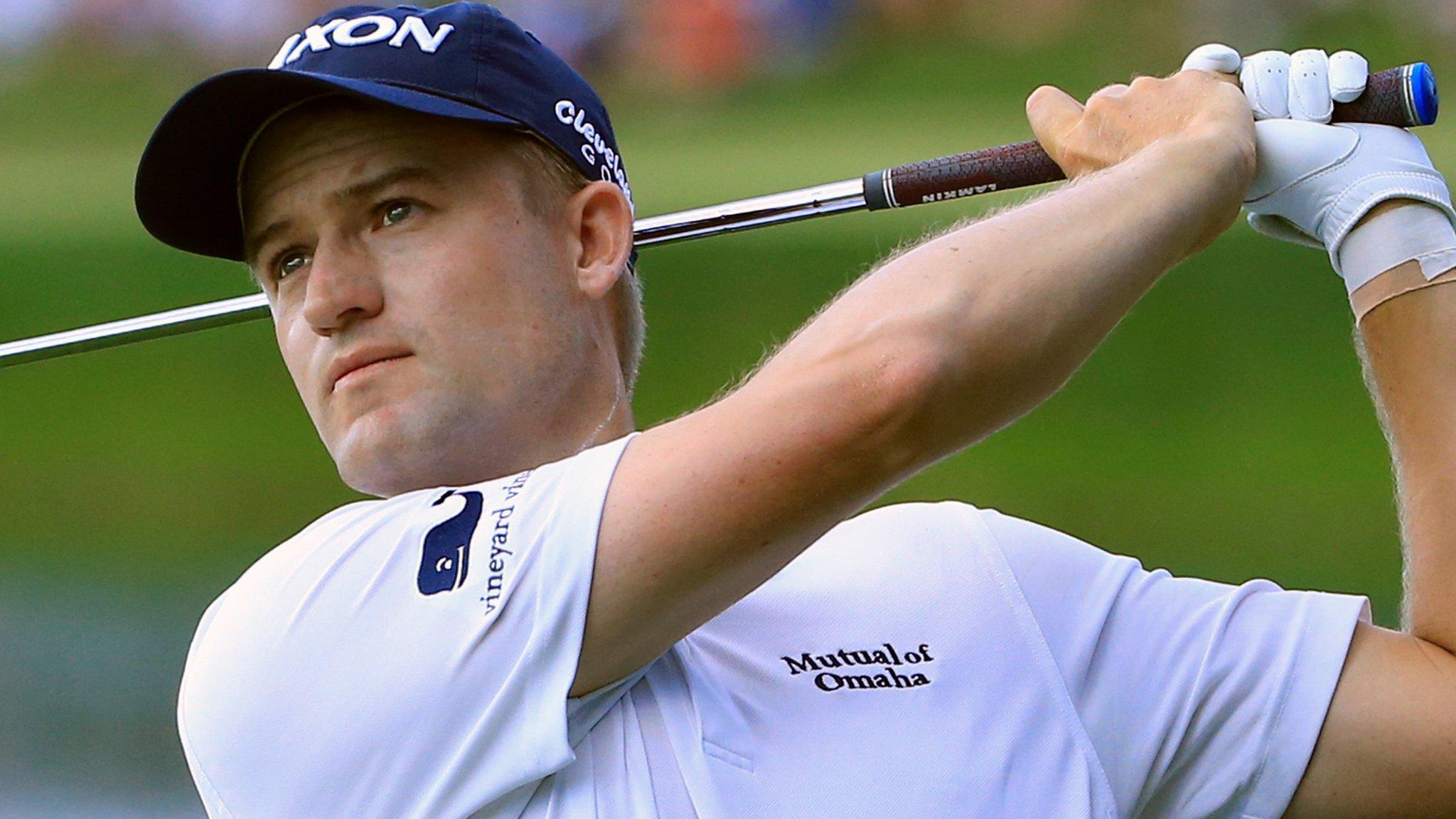Rio Olympics 2016: Golf needs time to grow on return to Games
- Published
For all the controversy around golf's return to the Olympics, there was one thing we could be sure of: there would not be much of a challenge from defending champion George Lyon, since he died in 1938, aged 79.
After a 112-year wait for another Olympic shot, it's fair to say the atmosphere at the Marapendi course at 0730 Rio time on Thursday was a little muted.
It wasn't the fault of the man chosen to take the opening tee-shot, Brazil's Adilson da Silva, although his draw in his home country is limited; the 44-year-old, whose highest ever world ranking was 215, lives in South Africa and has played in Brazil just once in the last 20 years.
This was about absence as much as the present, not so much an "I was there" moment as "I was there but none the world's top four players fancied it".
No Rory McIlroy, no Jordan Spieth. No Jason Day, no Dustin Johnson. No Adam Scott either, or US Open runner-up Shane Lowry, or Hideki Matsuyama or Louis Oosthuizen, let alone Tiger Woods, the dominant force in the game when golf was readmitted to the Olympics back in 2009, now less an ambassador than an invalid.
Many of those big names pulled out over fears about the Zika virus. Having walked the course on Thursday and seen more capybaras than mosquitoes, you might wonder whether golf deserves to be here at all.

The capybara is the largest rodent on earth, closely related to the guinea pig, it can weigh more than 45 kg
There is certainly something discombobulating about seeing a giant sculpture of the five Olympic rings within sand-wedge distance of a tee box, about seeing all the familiar furniture of a Games being used to dress a golf course. It is two discrete worlds being merged under duress, a forced marriage that no-one is sure will last the distance.
For the spectators who are here it's actually a rather pleasant experience. So close can you get to the players that you can hear their breathing. Masters champion Danny Willett and USA's Matt Kuchar are followed by a gallery so intimate they could almost be rules officials, if not caddies.
Unfortunately that's because there aren't many spectators at all. With the course way out west of Rio's pumping heart and Brazil having no golfing back-story to speak of, this has been one of the harder sells of an Olympics that has seen empty seats even at the beach volleyball on Copacabana.

Brazil's Adilson da Silva hits the first Olympic golf shot in 112 years, watched by a sparse crowd
It is being sold as a chance to grow the game, with the course returning to public property after the Games and designed, with its wide fairways and absence of trees or rough, to be enjoyed by the dabbling amateur as much as the reluctant millionaire.
In some ways it has already expanded the market. The last time golf was played at the Olympics, the competitors were drawn from only two nations, the USA and Canada. Here there are 60 men and 60 women, flying in from 41 countries.
Whether golf has ever really fitted in at an Olympics is another matter. It was absent from the first modern Games, in Athens in 1896, for the unarguable reason that there were no golf courses in Greece.
In 1900 in Paris it was played across eight days. The precursors to Willett and his British team-mate Justin Rose, Walter Rutherford and David Robertson, won silver and bronze, although had you mentioned Team GB to them they would have either looked at you blankly or had you tried for treason.
Things were not much clearer in the women's competition, where the champion Margaret Abbott only entered because she happened to be on holiday in France with her mother, and was under the impression she was competing in the Ladies Amateur Championship of Paris rather than the Olympics.
Even Lyon himself, the last gold medallist before this week, was something of a leftfield champion, having only taken up the sport aged 38 and enjoyed most of his sporting success before Paris as a cricketer in his native Canada.
So long has golf been excluded since then that tug-of-war, rope climbing and pistol duelling have all featured on the Olympic schedule more recently.
But this is a golden chance for the game, all the same.
The course itself is fine - not hugely interesting, but testing when the wind gets up, as it tends to in the afternoon, and reflective of its natural coastal geography with sand and wild grasses lining the fairways, and the colour of each bunker depending on the native subsoil found there.
Crowds are supposed to improve each day, with organisers claiming Sunday's final round is already a sell-out. Despite all those high-profile no-shows there are still plenty of Major wins - Padraig Harrington's three, Henrik Stenson's newly-claimed Open title, Bubba Watson's two Masters - and plenty looking to make up for Majors missing, not least Rickie Fowler and Sergio Garcia.

Sweden's Henrik Stenson claimed his first major by winning this year's Open Championship at Royal Troon
And this is only the start. Just as no-one would pass judgement on a Major after only the first round has been completed, so this Olympic tournament must be given time to develop. The strokeplay format arguably may not be as accessible as matchplay might have been to novice spectators nor as alluring to the grizzled, but the medal format provides a novel twist to the scoring: will the man in third place on the 18th, two shots behind the leader, go for broke for the win as you might expect on the PGA Tour, or lay up to protect his possible bronze?
Tennis, the closest equivalent to golf among professional Olympic sports, took its own time to flourish when it was readmitted to the Games in 1988. Steffi Graf may have won the women's gold, but the men's champion was the unheralded if aesthetically pleasing Miloslav Mecir, with only three of the world's top 10 men taking part. By London 2012, 24 years later, the injured Rafael Nadal was the only missing player from the world's elite.
The players too have an opportunity to embrace a new experience in a sometimes homogenous golfing environment. Rose is relishing it, taking part in the opening ceremony at the Maracana, staying in the athletes' village, hanging out with compatriots he had never met before from sports he knew little about.
He was rewarded on Thursday morning with the first hole-in-one in Olympic history, a pleasing moment of serendipity on an otherwise underwhelming day. Da Silva, too, striped that first tee-shot straight down the middle of the fairway.
Golf needs its stars that are here to shine. When George Lyon travelled to London in 1908 to defend his title, he found the event cancelled two days before it was due to start due to a series of administrative errors. Another self-inflicted wound like that might just take another 112 years to heal.
- Published9 August 2016

- Published9 August 2016
